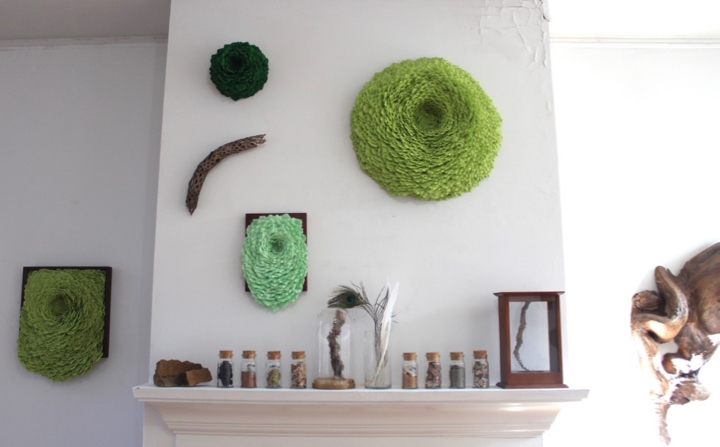
Amanda Roberts
Lunar Spell Book.
Amanda Roberts’s Lunar Spell Book is emblematic of “Witchy” — the exhibit now running at the Ely Center of Contemporary Art through April 19 — not only because of its marriage of ancient ideas about magic possibly at play in the modern world. It’s also because it shares a wall with a dozen other pieces of art that, individually and collectively, become a celebration of feminine power in all its forms.

Austin Furtak-Cole
Pink Triangle.
A sister exhibit also on the walls of the Ely Center, “Extra/Almost Human,” shares in that celebration, so seamlessly that the two shows blend into one another. As an accompanying note states about Austin Furtak-Cole’s Pink Triangle, “a pair of hands holds female genitalia like a powerful talisman of the eternal feminine, while a dark hand cradles an unknown bodily or geological item.

Sarah Geragotelis
The Forest Bather Discovers The Book Of All Things.
The two exhibits — which together involve dozens of artists — draw much of their strength from diving into the mythological and spiritual, and making connections with nature. Even without the title, The Forest Bather Discovers The Book Of All Things, Sarah Geragotelis’s sculpture feels like it could belong as the centerpiece of a spiritual place, celebrating a belief system that hastens the coming of the matriarchy.

Scott Schuldt
Huldre.
Right nearby, in the same gallery, Scott Schuldt’s Huldre thrums with a similar power. The huldre is a creature out of Scandinavian folklore, a forest seductress similar to a mermaid. Some artistic depictions of huldre make them conventionally beautiful. Schuldt’s version of the huldre is alluring because of its strength, pulled from nature and amplified into something supernaturally compelling.

Susan Clinard
Closet Stories #1 and #2.
Meanwhile, Susan Clinard’s plaintive works can be interpreted as both a meditation on the lasting scars from abuse and the power to heal and grow in the aftermath. The women in her mixed-media pieces may be hurt, but they’re not giving up.

Brita DeMars
Releasing the Dark Things.
On the stairs to the galleries on the second floor, Brita DeMars’s portrait features a woman seated in a position that feels relaxed yet powerful, the expression on her face patient and assured. The title explains the right half of the painting, as the dark insects flee the scene. The painting takes it a step further, as on left side, the subject lets in the light.

Molly Gambardella
Second Growth.
Molly Gamberdella’s pieces occupy a room to themselves at the top of the stairs; they’re arranged in such a way to feel almost like a magic shop. “I believe that the essence of magic in our modern world is imagination,” Gambardella has written in an accompanying statement. “Magic is the ability to imagine the impossible. Nature is that space, that silence where the imagination can grow. From the magic of imagining, the second part of the magic is will, and from that imagining we can get the will to change the world.”
Gambardella explains that she is inspired by the life in the natural world that she has observed while going on hikes. A growing lichen can “remind us that progress, which is often painfully slow, is still a miraculous accomplishment. They teach us that joy can spread and beauty can bloom” — even out of the frame — “in seemingly impossible conditions. Like people, the miracle of their existence is worth celebrating.”

Jisu Sheen
Gwishin (ghost).
Jisu Sheen’s haunting painting partakes of a different, more eerie sort of magic.

Suzanna Scott
Coin Cunts.
And Suzanna Scott’s piece ferociously reclaims a jarring word with a small dose of humor and without compromise.

The ideas swirling around the two exhibits — the celebration of the power of women, and the heady mix of sexuality, fertility, and creativity that the pieces conjure up — sometimes work best when pieces in a gallery are taken in together. Lia Davido’s untitled sculpture can be read as a sign on a gate; pass by it and engage with Jacqueline Gleisner’s wordplay and Grace Hager’s painting in the hallway beyond.

And Fukuko Harris’s Transformation can seem like a meteor that tore through the roof — or like the center of gravity for the myriad pieces around it.

In a final gallery, separated from the others by a black curtain, a video installation helps pull it all together, as artists Amira Brown, Julian Miholics, and Yovska “use the monster motif … to reflect on their own sense of otherness or being. Brown uses harpies to exemplify experiences as a young black artist; Miholics draws parallels between transgender identity and werewolf lore; Yovska uses drag a a medium to explore the intersections of immigrant identity and queerness.”
The art on display at the Ely Center connects the up-to-the-minute present to the distant past, and to centuries-old folklore that still retains its power. Its testament to the power of women is as much a display of strength as a celebration. It’s a party with bite.
“Witchy” and “Extra/Almost Human” run at the Ely Center of Contemporary Art, 51 Trumbull St., through April 19. Visit the center’s website for gallery hours and more information.